A New Microwave Sensor Based on the Moore Fractal Structure to Detect Water Content in Crude Oil
Abstract
:1. Introduction
2. Geometric Details of the Sensor
3. Moore Cell Characterizations
4. Design Methodology and Systematic Study
- A.
- Transmission line designFirst of all, the authors designed a 50 Ω transmission line, see Figure 4, to ensure power motion fluently from port 1 to port 2. Next, a single slot was introduced to the transmission line to leak the electromagnetic fringing in a specific area [13]. Such fringing increased the field penetration to the SUT, as will be seen later. Therefore, 2 slots were included instead of 1 slot around the transmission line center to increase the field fringing.Now, S21 spectra were evaluated using CST MWS for the frequency bands from 0.1 GHz up to 4 GHz. As seen in Figure 5, it was found that introducing a single-slot reduced S21 significantly over the entire frequency band of interest. However, increasing the slot number to dual slots reduced S21 rapidly below −40 dB. Such a reduction in the magnitude of S21 value would be invested for the detection process. Nevertheless, such slots created capacitive coupling to store the electromagnetic energy at high frequencies [33]. It is good to mention that, for microwave resonator design, the frequency resonances can be observed from the S12 spectra, as explained in [1].
- B.
- T-resonator effectsNow, the proposed T-resonator, as seen in Figure 6a, performance in terms of S21 spectra was evaluated parametrically by changing the trace line length and the transmission line length. Therefore, trace length (L) was changed from 18 mm to 20 mm with a step of 1 mm. Such length was limited to these values to avoid any intersection between the conductor parts of the proposed sensor. In general, it was found that the proposed T-resonator showed a frequency resonance around 0.8 GHz that was very close to the resonance of the proposed fractal unit cell. However, the second mode was found far away from the second mode of the proposed Moore, as seen in the previous section. Such conclusions motivated us to consider the first mode for the sensing process only. Nevertheless, it was found that when the T-resonator length was 18 mm, the frequency resonance was shifted to 0.8 GHz, as seen in Figure 6b. However, the frequency resonance at the first mode, around 0.9 GHz, was found to be unaffected by increasing the length after 19 mm. Therefore, the T-resonator length was considered 18 mm for the proposed cell geometry. Then, the transmission line length (W) was changed from 18 mm to 36 mm with a step of 9 mm. We found from Figure 6c that the proposed structure showed a frequency resonance around 0.8 GHz, which was the frequency band of interest at 36 mm. However, the other two lengths, at 18 mm and 27 mm, showed frequency resonances out of the frequency band of inters. Therefore, in the proposed design, the length of the transmission line was fixed to 36 mm.
- C.
- Moore unit cell introductionThe proposed Moore unit cells based on the 2nd and 4th iterations, see Figure 7a, were only introduced to the sensor design by placing four of them connected directly to the transmission line at the slots locations. The proposed study was considered to ensure the effects of changing the iteration order in the final design stage through monitoring the S21 spectra for the two cases, as seen in Figure 7b.It would be very important to emphasize that the authors’ consideration of the 4th iteration in their final design for two main reasons: first, increasing the field intensity by increasing the fractal iteration that was very desirable for the detection process [32]. In addition, the 4th iteration generated a frequency resonance around 1 GHz that would be shifted to the lower frequencies after introducing the pans and the SUT. This makes the proposed sensor operation in the range of 0.8 GHz that was a design specification for this work. As well as maintaining the sensor operation with a low-frequency band, which is very useful for field penetration inside the SUT [32].
- D.
- Shapes of PansThis section discusses the effects of introducing different shapes of pans to select the suitable geometry of the proposed sensor. The pans should cover the area of the Moore structure to ensure the field penetration to the SUT. The first suggested pan shape, see Figure 8a, assumed a rectangular geometry with a size of 40 × 44 × 0.6 mm3. The second shape was considered as an elliptic cylinder that was scratched from a rectangular area with a height of 0.6 mm, as seen in Figure 8b. Another shape of the pan was suggested by using a rectangular plate having a compact size equal to 40 × 44 × 0.6 mm3 with a whittle shape, as presented in Figure 8c. This geometry was assumed based on the observed electric field intensity distributions that will be seen later. It is good to mention that all suggested geometries have the same height, 0.6 mm, to avoid any discrepancy during the design. In addition, this value was assumed based on the suggested height from [11,34] that agrees well with our parametric study, as will be shown later.From the simulation results using CST MWS, it was found that the proposed sensor based on rectangular pans provided S21 of −31 dB with a resonant frequency shift of 156 MHz, as seen in Figure 8d. After introducing the other pans to the proposed sensor, S21 was found to be −33 dB with a resonant frequency reduction of around 148 MHz from the 0.8 GHz, as depicted in Figure 8d. The simulated results, see Figure 8d, show that the proposed sensor based on the whittle shape provides S21 equal to −34 dB with a resonant frequency shift of 140 MHz with respect to 0.8 GHz. Therefore, we considered the whittle shape pans in our next study; because it provides us the minimum frequency shift.
- E.
- Equivalent circuit modelThe proposed sensor geometry based on the T-resonator and fractal Moore geometry of the 4th iteration was analyzed analytically using an equivalent circuit model. We derived the equivalent circuit model of the proposed structure based on the lumped elements Richard model [35]. As seen in Figure 9a, the proposed circuit model was considered by connecting a 50 Ω input impedance RF source in series with an (R-L-C) parallel branch. The R-L-C branch was denoted for Moore geometry to be named as Lm, Rm, and Cm. The main transmission line was characterized by an inductive part LT and a capacitive air gaps Cgap that was shown previously in Figure 1. The T-resonator as a load was connected to the center of the transmission line and defined as LT-resonator in parallel with a capacitor of CT-resonator. This branch was connected serially with a resistor of RT-resonator. Each of Rp and Cp was connected in parallel with the equivalent circuit model to denote the pans effects. The S-parameters were evaluated for the proposed circuit model and compared to those obtained from CST MWS. A good agreement was achieved according to the listed lumped elements, which were simulated in Adjulent Devices Simulator (ADS), as seen in Table 1.
5. Numerical Analysis
- 0.5376
- −0.03488
- 0.01997
- −0.005978
- 28.03
- 5.877
- −4.424
- 2.266
- 0.07138
- 0.01182
- −0.0121
6. Fabrication and Experimental Validation
7. Conclusions
Author Contributions
Funding
Institutional Review Board Statement
Informed Consent Statement
Data Availability Statement
Acknowledgments
Conflicts of Interest
References
- Abdulkarim, Y.I.; Deng, L.; Karaaslan, M.; Dalgaç, Ş.; Mahmud, R.H.; Ozkan Alkurt, F.; Muhammadsharif, F.F.; Awl, H.N.; Huang, S.; Luo, H. The Detection of Chemical Materials with a Metamaterial-Based Sensor Incorporating Oval Wing Resonators. Electronics 2020, 9, 825. [Google Scholar] [CrossRef]
- Obaid, S.M.; Elwi, T.A.; Ilyas, M. Fractal Minkowski-Shaped Resonator for Noninvasive Biomedical Measurements: Blood Glucose Test. Prog. Electromagn. Res. C 2021, 107, 143–156. [Google Scholar] [CrossRef]
- Biris, A.S.; Al-Rizzo, H.; Elwi, T.; Rucker, D. Nano and Micro Based Antennas and Sensors and Methods of Making Same. U.S. Patent 8692716, 8 April 2014. [Google Scholar]
- Makeyev, Y.V.; Lifanov, A.P.; Sovloukov, A.S. Microwave measurement of water content in flowing crude oil with improved accuracy. In Proceedings of the 2014 24th International Crimean Conference Microwave & Telecommunication Technology, Sevastopol, Ukraine, 7–13 September 2014; pp. 956–957. [Google Scholar]
- Ashton, S.L.; Cutmore, N.G.; Roach, G.L.; Watt, J.S.; Zastawny, H.W.; McEwan, A.J. Development and trial of microwave techniques for measurement of multiphase flow of oil, water and gas. In Proceedings of the SPE Asia Pacific Oil and Gas Conference, Society of Petroleum Engineers, Melbourne, Australia, 7 November 1994. [Google Scholar]
- García-Golding, F.; Giallorenzo, M.; Moreno, N.; Chang, V. Sensor for determining the water content of oil-in-water emulsion by specific admittance measurement. Sens. Actuators A Phys. 1995, 47, 337–341. [Google Scholar] [CrossRef]
- Chang, L.; Xiu, G.Y. Research on ultra short-wave method to measure water content of crude oil. In Proceedings of the 9th International Conference on Signal Processing, Beijing, China, 26–29 October 2008; pp. 2956–2959. [Google Scholar]
- Elwi, T.A.; Khudhayer, W.J. A Passive Wireless Gas Sensor Based on Microstrip Antenna with Copper Nanorods. Prog. Electromagn. Res. B 2013, 55, 347–364. [Google Scholar] [CrossRef] [Green Version]
- Aslam, M.Z.; Tang, T.B. A High-Resolution Capacitive Sensing System for the Measurement of Water Content in Crude Oil. Sensors 2014, 14, 11351–11361. [Google Scholar] [CrossRef] [Green Version]
- Elwi, T.A. Metamaterial based a printed monopole antenna for sensing applications. Int. J. RF Microw. Comput.-Aided Eng. 2018, 28, e21470. [Google Scholar] [CrossRef]
- Elwi, T.A. On the Percentage Quantization of the Moisture Content in the Iraqi Petroleum Productions Using Microwave Sensing. J. Al-Ma’moon College 2016, 28, 262–277. [Google Scholar]
- Rahman, M.N.; Islam, M.T.; Samsuzzaman, M. Design and analysis of a resonator-based metamaterial for sensor applications. Microw. Opt. Technol. Lett. 2018, 60, 694–698. [Google Scholar] [CrossRef]
- Haq, T.U.; Ruan, C.; Zhang, X.; Ullah, S. Complementary metamaterial sensor for nondestructive evaluation of dielectric substrates. Sensors 2019, 19, 2100. [Google Scholar] [CrossRef] [Green Version]
- Kuylenstierna, D.; Vorobiev, A.; Linner, P.; Gevorgian, S. Composite right/left handed transmission line phase shifter using ferroelectric varactors. Microw. Wirel. Compon. Lett. 2006, 16, 167–169. [Google Scholar] [CrossRef]
- Saadat-Safa, M.; Nayyeri, V.; Khanjarian, M.; Soleimani, M.; Ramahi, O.M. A CSRR-based sensor for full characterization of magneto-dielectric materials. IEEE Trans. Microw. Theory Tech. 2019, 67, 806–814. [Google Scholar] [CrossRef]
- Zhang, X.; Ruan, C.; Haq, T.U.; Chen, K. High-sensitivity microwave sensor for liquid characterization using a complementary circular spiral resonator. Sensors 2019, 19, 787. [Google Scholar] [CrossRef] [PubMed] [Green Version]
- Chuma, E.L.; Iano, Y.; Fontgalland, G.; Roger, L.L.B. Microwave sensor for liquid dielectric characterization based on metamaterial complementary split ring resonator. IEEE Sens. J. 2018, 18, 9978–9983. [Google Scholar] [CrossRef]
- Tiwari, N.K.; Singh, S.P.; Akhtar, M.J. Novel improved sensitivity planar microwave probe for adulteration detection in edible oils. IEEE Microw. Wirel. Compon. Lett. 2019, 29, 164–166. [Google Scholar] [CrossRef]
- Su, L.; Mata-Contreras, J.; Vélez, P.; Fernández-Prieto, A.; Martín, F. Analytical method to estimate the complex permittivity of oil samples. Sensors 2018, 18, 984. [Google Scholar] [CrossRef] [PubMed] [Green Version]
- Lee, C.-S.; Yang, C.-L. Thickness and permittivity measurement in multi-layered dielectric structures using complementary split-ring resonators. IEEE Sens. J. 2014, 14, 695–700. [Google Scholar] [CrossRef]
- Su, L.; Naqui, J.; Mata-Contreras, J.; Martín, F. Modeling and applications of metamaterial transmission lines loaded with pairs of coupled complementary split-ring resonators (CSRRs). IEEE Microw. Wirel. Compon. Lett. 2016, 15, 154–157. [Google Scholar] [CrossRef] [Green Version]
- Alibakhshi-Kenari, M.; Naser-Moghadasi, M.; Sadeghzadeh, R.A. Bandwidth and radiation specifications enhancement of monopole antennas loaded with split ring resonators. IET Microw. Antennas Propag. 2015, 9, 1487–1496. [Google Scholar] [CrossRef]
- Alibakhshikenari, M.; Virdee, B.S.; Limiti, E. Compact Single Layer Travelling-Wave Antenna Design Using Metamaterial Transmission Lines. Radio Sci. 2017, 52, 1510–1521. [Google Scholar] [CrossRef] [Green Version]
- Javed, A.; Arif, A.; Zubair, M.; Mehmood, M.Q.; Riaz, K. A Low-Cost Multiple Complementary Split-Ring Resonator-Based Microwave Sensor for Contactless Dielectric Characterization of Liquids. IEEE Sens. J. 2020, 20, 11326–11334. [Google Scholar] [CrossRef]
- Weina, L.; Haoran, S.; Lie, X. A Microwave Method for Dielectric Characterization Measurement of Small Liquids Using a Metamaterial-Based Sensor. Sensors 2018, 18, 1438. [Google Scholar]
- Crnojevic-Bengin, V.; Radonic, V.; Jokanovic, B. Fractal geometries of complementary split-ring resonators. IEEE Trans. Microw. Theory Tech. 2008, 56, 2312–2321. [Google Scholar] [CrossRef]
- Seena, M.; Ajith, R.; Vincent, M. Propagation Characteristics of Superconducting Slot Line Based on Ferroelectric Substrate. J. Supercond. Nov. Magn. 2013, 26, 2899–2904. [Google Scholar]
- Jawad, K.A. A new microstrip-fed printed slot antenna based on Moore space-filling geometry. In Proceedings of the 2009 Loughborough Antennas & Propagation Conference, Loughborough, UK, 16–17 November 2009; pp. 449–452. [Google Scholar]
- Abdulkarim, Y.I.; Muharrem, K.; Olcay, A.; Emin, U. Metamaterial absorber sensor design by incorporating swastika shaped resonator to determination of the liquid chemicals depending on electrical characteristics. Phys. E Low-Dimens. Syst. Nanostr. 2019, 114, 113593. [Google Scholar] [CrossRef]
- Lätti, K.-P.; Kettunen, M.; Ström, J.-P.; Silventoinen, P. A Review of Microstrip T-Resonator Method in Determining the Dielectric Properties of Printed Circuit Board Materials. IEEE Trans. Instrum. Meas. 2007, 56, 1845–1850. [Google Scholar] [CrossRef]
- Borwen, Y.; Ching, C.-Y.; Chin, Y.-P.; Pei, W.-H.; Ja, L.-Y. Frequency-dependent skin penetration depth of terahertz radiation determined by water sorption–desorption. Opt. Express 2018, 26, 22709. [Google Scholar]
- Xu, H.-X.; Wang, G.-M.; Zhang, C.-X. Fractal-Shaped Metamaterials and Applications to Enhanced-Performance Devices Exhibiting High Selectivity. Int. J. Antennas Propag. 2012, 2012, 515167. [Google Scholar] [CrossRef]
- Amer, A.A.; Iulia, A.M.; Norocel, C.; Mihaela, P. Modified Split Ring Resonators Sensor for Accurate Complex Permittivity Measurements of Solid Dielectrics. Sensors 2020, 20, 6855. [Google Scholar]
- Krzysztofik, W.J. Fractal geometry in electromagnetics applications—From antenna to metamaterials. Microw. Rev. 2013, 19, 3–14. [Google Scholar]
- Slawomir, G.; Robert, S.; Krzysztof, W. Realization of High-Performance Broadband Quadrature Directional Couplers in UMS PH25 Technology. Electronics 2019, 8, 1520. [Google Scholar]
- Alibakhshikenari, M.; Khalily, M.; Virdee, B.S.; See, C.H.; Abd-Alhameed, R.A.; Limiti, E. Mutual Coupling Suppression Between Two Closely Placed Microstrip Patches Using EM-Bandgap Metamaterial Fractal Loading. IEEE Access 2019, 7, 23606–23614. [Google Scholar] [CrossRef]
- Qing, L.; Bo, C.; Jinye, P.; Sheng, T. A Visual Measurement of Water Content of Crude Oil Based on Image Grayscale Accumulated Value Difference. Sensors 2019, 19, 2963. [Google Scholar]
- Porwal, P.; Syed, A.; Bhimalapuram, P.; Sau, T.K. Design of fractal geometry based rf sensor for detection of complex permittivity of unknown sample. In Proceedings of the 2017 IEEE Asia Pacific Microwave Conference (APMC), Kuala Lumpur, Malaysia, 13–16 November 2017; pp. 1310–1312. [Google Scholar]
- Arif, A.; Zubair, A.; Riaz, K.; Mehmood, M.Q.; Zubair, M. A Novel Cesaro Fractal EBG-Based Sensing Platform for Dielectric Characterization of Liquids. IEEE Trans. Antennas Propag. 2021, 69, 2887–2895. [Google Scholar] [CrossRef]
- Ari, S.; Ebbe, N.; Martti, T. Mixing Formulae and Experimental Results for the Dielectric Constant of Snow. Glaciology 1985, 31, 163–170. [Google Scholar]
- Zhao, C.; Wu, G.; Li, Y. Measurement of water content of oil-water two-phase flows using dual-frequency microwave method in combination with deep neural network. Measurement 2018, 131, 92–99. [Google Scholar] [CrossRef]

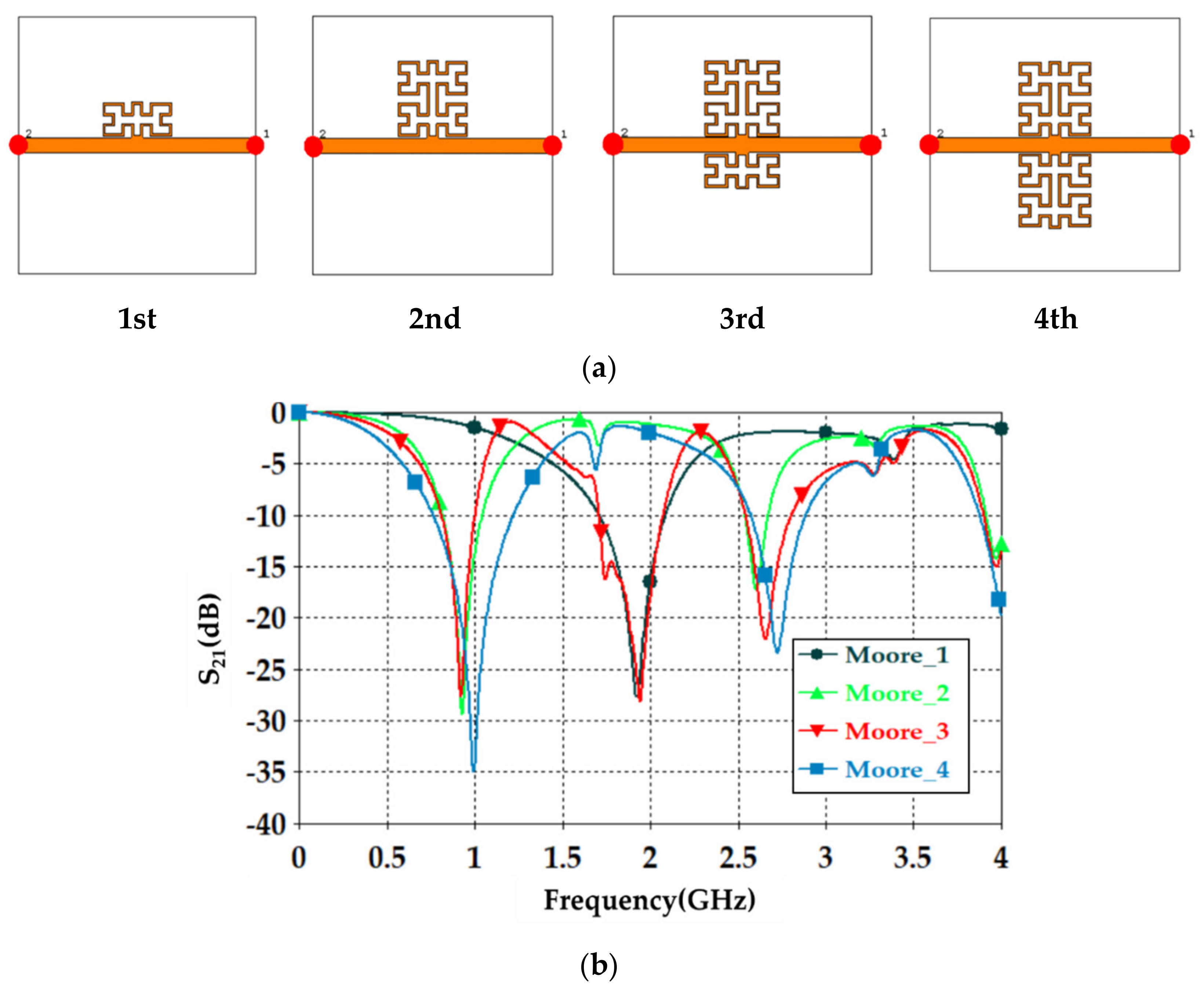
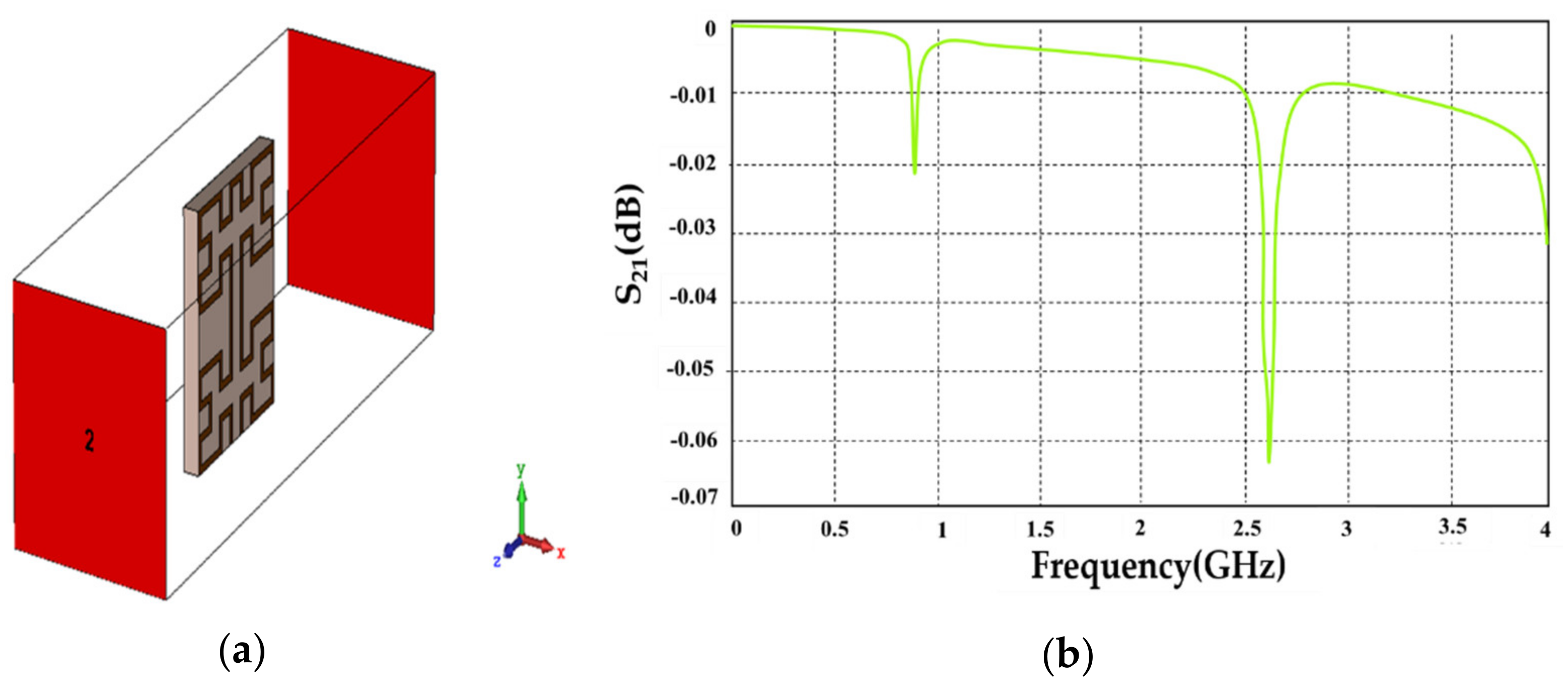

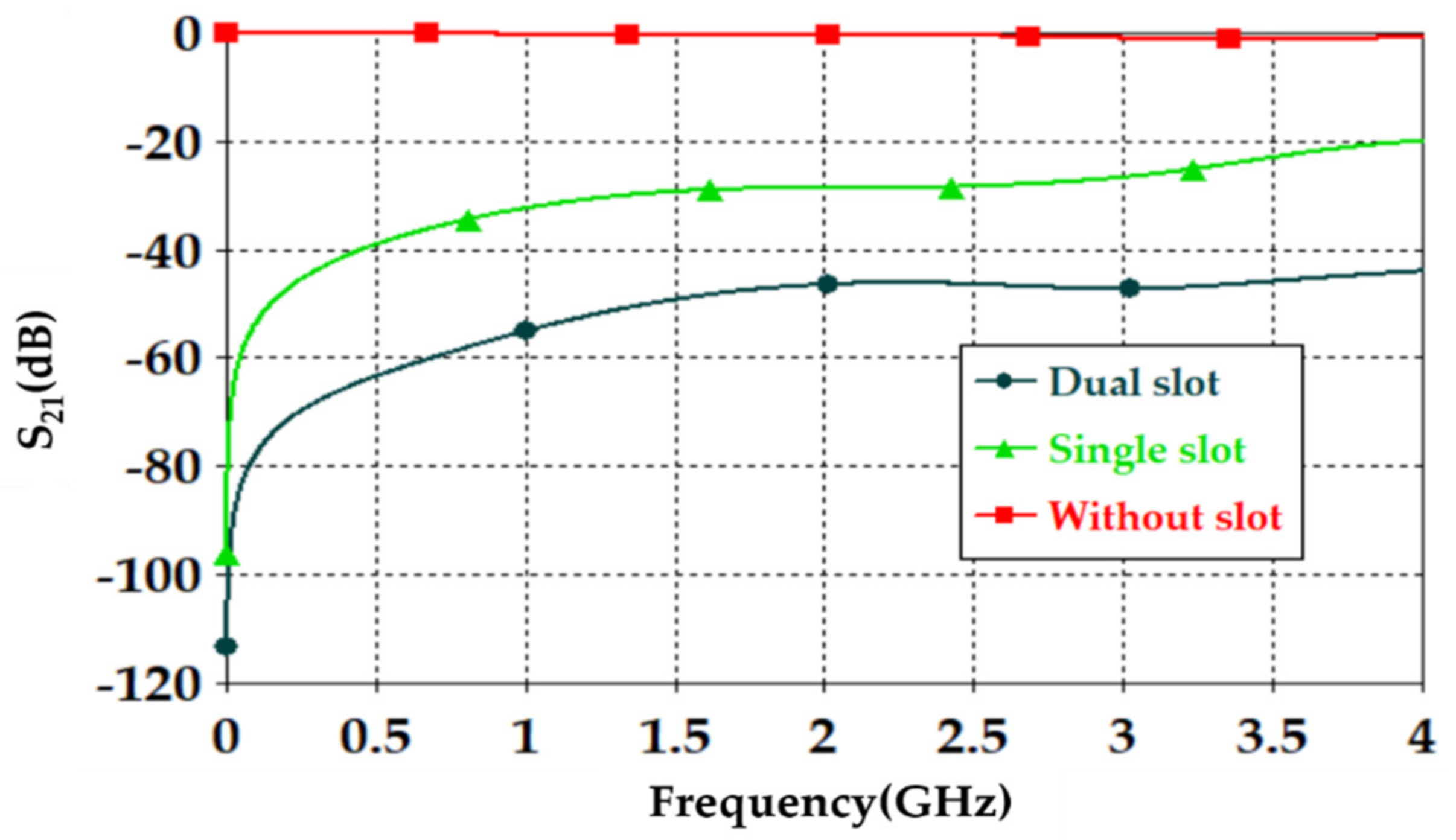
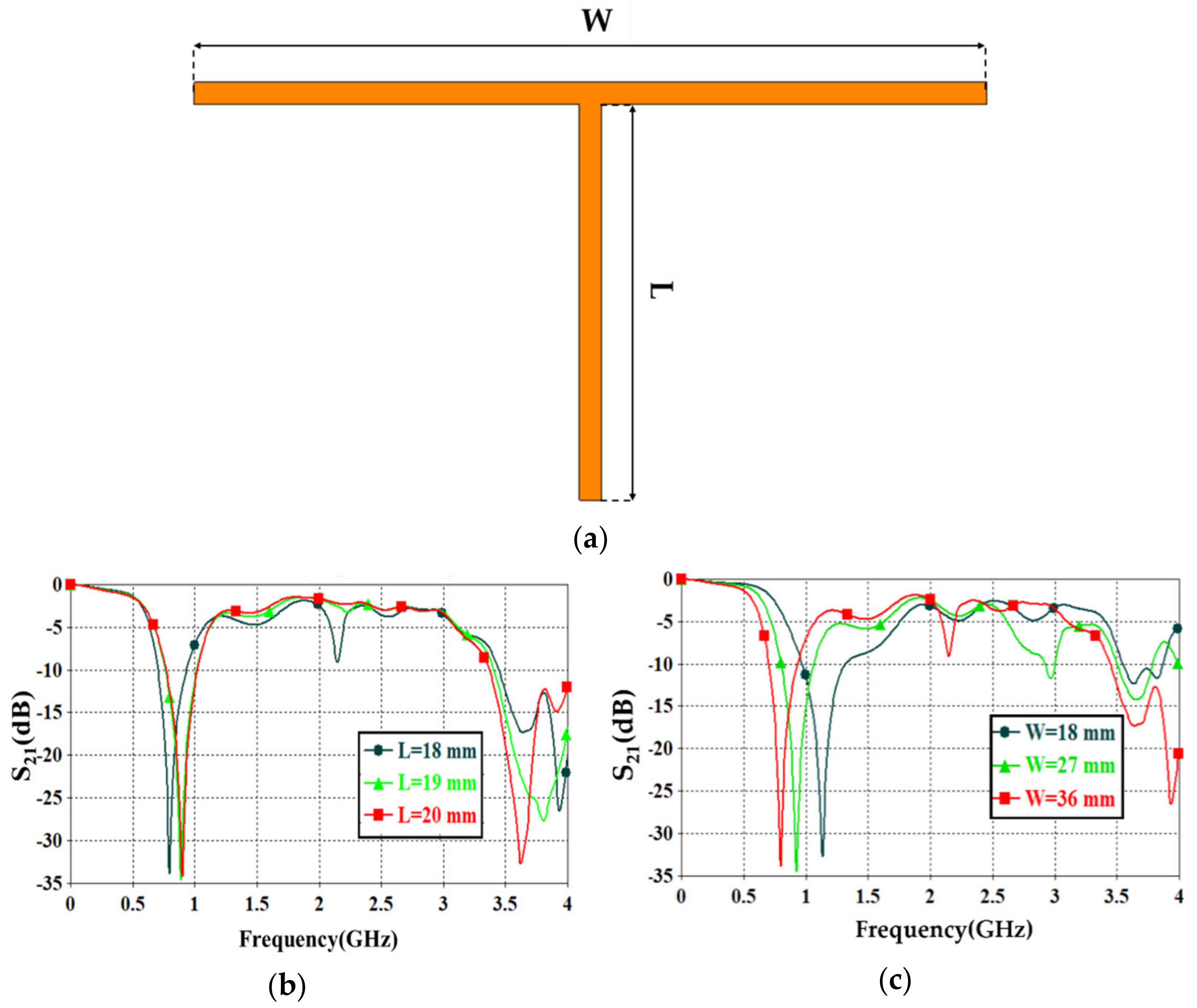

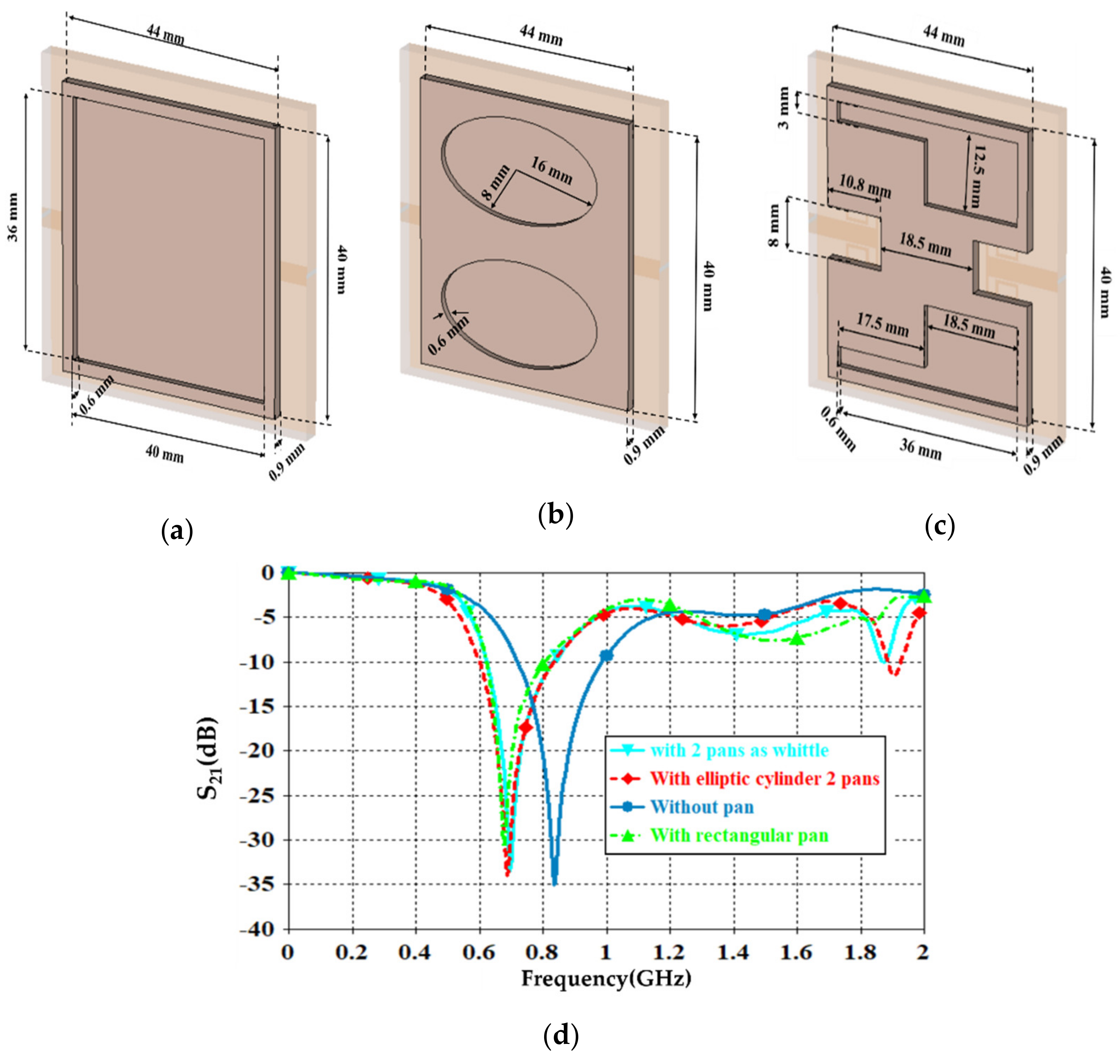
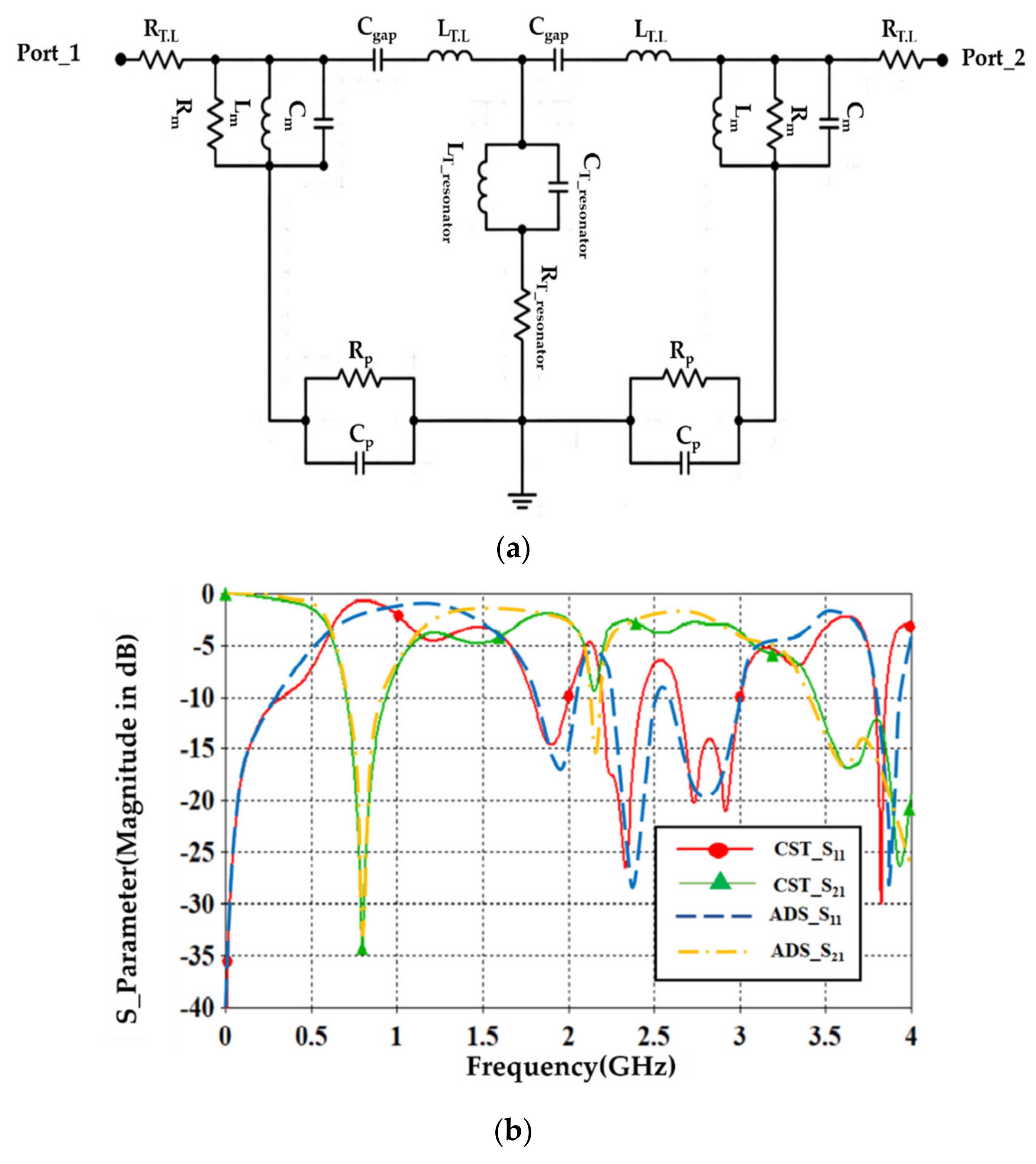


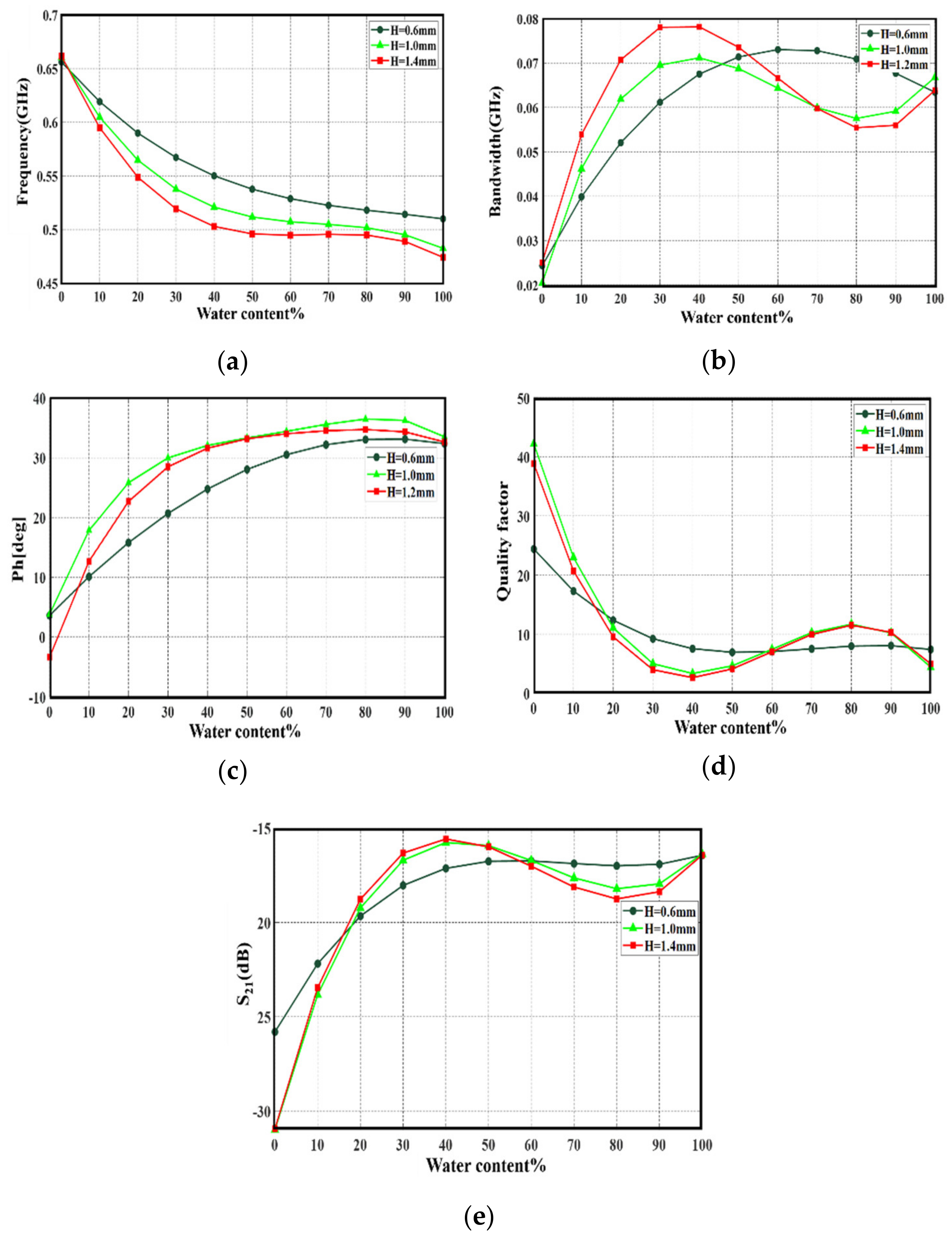

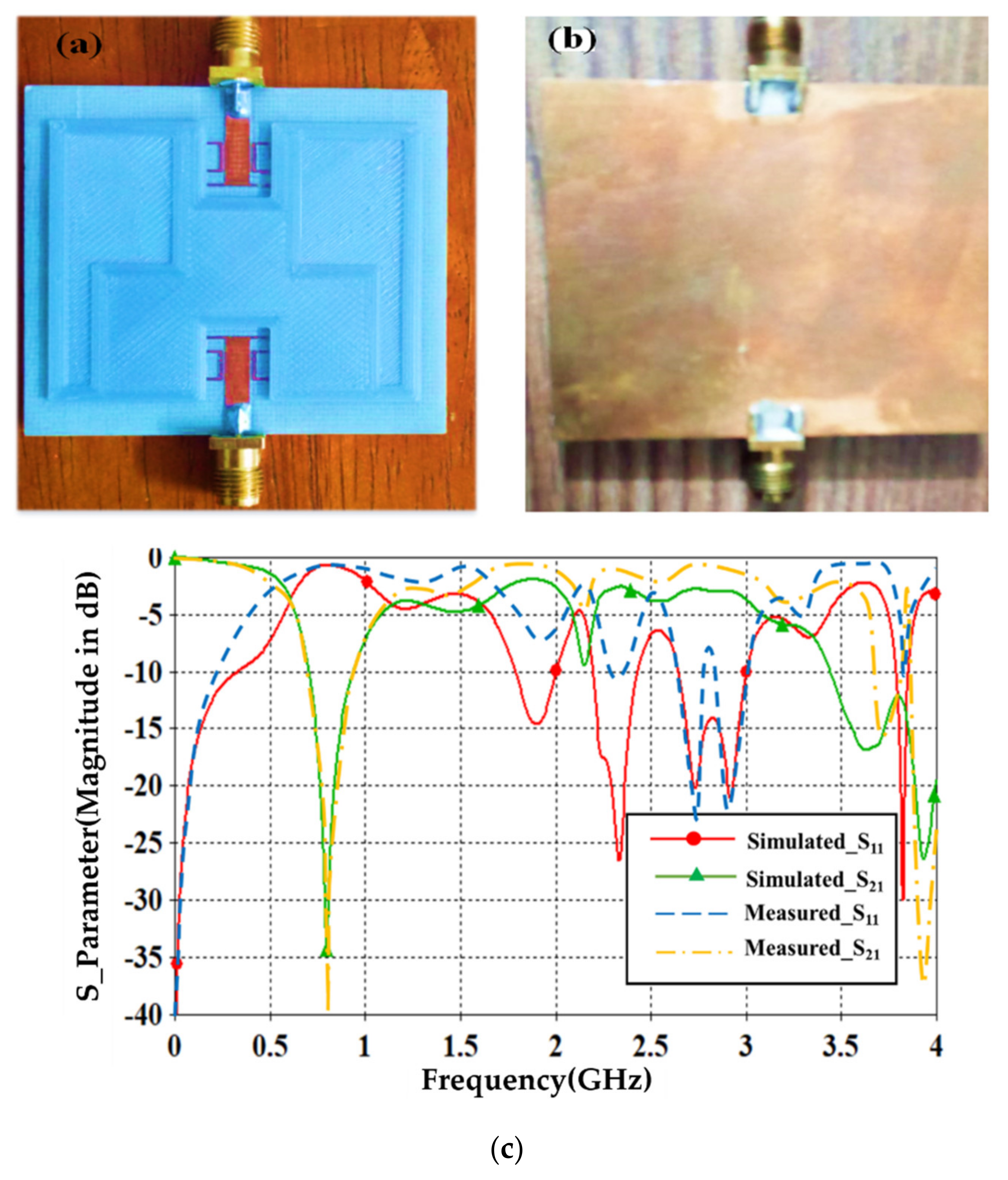
| RT.L | LT.L | Lm | Cm | Rm | Cgap | LT-resonator | CT-resonator | RT-resonator | CP | RP |
|---|---|---|---|---|---|---|---|---|---|---|
| 50 Ω | 9 nH | 0.1 nH | 2 pF | 10 Ω | 1.3 pF | 8nH | 6.1 pF | 101 Ω | 0.5 pF | 15 |
| Water% | Oil% | fr(GHz) | Δfr(GHz) | S21(dB) | B.W(GHz) | Ph[deg] | Q.F |
|---|---|---|---|---|---|---|---|
| 0 | 100 | 0.66 | 0 | −26.836 | 0.025926 | −0.510076 | 25.45707 |
| 10 | 90 | 0.612 | 0.04 | −20.346 | 0.038896 | 14.97738 | 15.73426 |
| 20 | 80 | 0.588 | 0.072 | −19.405 | 16.615898 | 16.615898 | 11.13172 |
| 30 | 70 | 0.576 | 0.084 | −19.278 | 18.615898 | 18.615898 | 11.29633 |
| 40 | 60 | 0.546 | 0.114 | −17.109 | 24.823846 | 24.823846 | 7.19737 |
| 50 | 50 | 0.54 | 0.12 | −16.882 | 33.194263 | 33.194263 | 7.20393 |
| 60 | 40 | 0.528 | 0.132 | −16.767 | 28.492114 | 28.492114 | 7.19159 |
| 70 | 30 | 0.522 | 0.138 | −16.738 | 29.431511 | 29.431511 | 7.738477 |
| 80 | 20 | 0.516 | 0.144 | −16.690 | 28.793417 | 28.793417 | 7.47847 |
| 90 | 10 | 0.5159 | 0.1444 | −16.713 | 36.325119 | 36.325119 | 7.78204 |
| 100 | 0 | 0.51 | 0.15 | −16.722 | 33.350711 | 33.350711 | 7.79387 |
| Water% | Oil% | fr(GHz) | Δfr(GHz) | S21(dB) | B.W(GHz) | Ph[deg] | Q.F | Error% |
|---|---|---|---|---|---|---|---|---|
| 3 | 97 | 0.671 | 0.0001 | −28.886 | 0.025 | 19.915 | 26.84 | 0.063 |
| 11 | 89 | 0.609 | 0.051 | −19.617 | 0.051 | 9.076 | 11.94 | 0.055 |
| 14 | 86 | 0.608 | 0.059 | −14.554 | 0.055 | 17.161 | 11.054 | 0.156 |
| 21 | 79 | 0.58 | 0.069 | −14.451 | 0.052 | 14.981 | 11.153 | 0.144 |
| 23 | 77 | 0.582 | 0.075 | −13.393 | 0.054 | 14.706 | 10.778 | 0.1787 |
| 28 | 72 | 0.575 | 0.081 | −19.278 | 0.058 | 28.292 | 9.914 | 3.064 × 10−3 |
| 34 | 66 | 0.574 | 0.084 | −21.803 | 0.049 | 23.428 | 11.714 | 0.059 |
| 40 | 60 | 0.546 | 0.112 | −17.392 | 0.076 | 23.996 | 7.184 | 0.057 |
| 46 | 54 | 0.541 | 0.114 | −14.992 | 0.078 | 23.956 | 6.936 | 0.069 |
| 52 | 48 | 0.54 | 0.124 | −17.052 | 0.073 | 34.263 | 7.397 | 5.01 × 10−3 |
| 55 | 45 | 0.527 | 0.133 | −15.986 | 0.079 | 27.969 | 6.671 | 0.025 |
| 61 | 39 | 0.527 | 0.131 | −17.716 | 0.077 | 32.335 | 6.844 | 0.027 |
| 66 | 34 | 0.523 | 0.141 | −15.928 | 0.073 | 27.916 | 7.164 | 0.027 |
| 71 | 29 | 0.521 | 0.14 | −16.767 | 0.07 | 29.049 | 7.442 | 1.875 × 10−3 |
| 72 | 28 | 0.516 | 0.143 | −13.493 | 0.072 | 29.385 | 7.167 | 0.108 |
| 76 | 24 | 0.516 | 0.144 | −17.071 | 0.069 | 35.281 | 7.478 | 8.21 × 10−3 |
| 80 | 20 | 0.516 | 0.144 | −15.907 | 0.071 | 36.091 | 7.268 | 0.028 |
| 85 | 15 | 0.516 | 0.144 | −15.993 | 0.069 | 31.907 | 7.478 | 0.024 |
| 91 | 9 | 0.516 | 0.144 | −15.532 | 0.067 | 35.319 | 7.701 | 0.035 |
| 95 | 5 | 0.513 | 0.148 | −12.314 | 0.068 | 34.926 | 7.544 | 0.0172 |
| 100 | 0 | 0.511 | 0.149 | −16.977 | 0.062 | 35.979 | 8.225 | 6.07 × 10−3 |
| Ref. | Type of Resonators | fr (GHz) | Area of Substrate (mm2) |
|---|---|---|---|
| [1] | Oval Wing Resonator | 8–10 | 35 × 35 |
| [15] | Complementary Circular Spiral Resonator | 2.4 | 20 × 28 |
| [16] | Complementary Split Ring Resonators | 2.4 | 30 × 25 |
| [23] | Multiple Complementary Split-Ring Resonator (MCSRR) | 2.45 | 35 × 25 |
| [24] | Split ring resonator | 1.9 | 28 × 28 |
| [40] | Cesaro Fractal Electromagnetic Bandgap Structure (EBG) | 2.45 | 82 × 82 |
| [41] | Fractal Peano Curve | 4.494 | 75 × 25 |
| This work | Moore Fractal Geometry | 0. 8 | 50 × 50 |
Publisher’s Note: MDPI stays neutral with regard to jurisdictional claims in published maps and institutional affiliations. |
© 2021 by the authors. Licensee MDPI, Basel, Switzerland. This article is an open access article distributed under the terms and conditions of the Creative Commons Attribution (CC BY) license (https://creativecommons.org/licenses/by/4.0/).
Share and Cite
Abdulsattar, R.K.; Elwi, T.A.; Abdul Hassain, Z.A. A New Microwave Sensor Based on the Moore Fractal Structure to Detect Water Content in Crude Oil. Sensors 2021, 21, 7143. https://doi.org/10.3390/s21217143
Abdulsattar RK, Elwi TA, Abdul Hassain ZA. A New Microwave Sensor Based on the Moore Fractal Structure to Detect Water Content in Crude Oil. Sensors. 2021; 21(21):7143. https://doi.org/10.3390/s21217143
Chicago/Turabian StyleAbdulsattar, Russul Khalid, Taha A. Elwi, and Zaid A. Abdul Hassain. 2021. "A New Microwave Sensor Based on the Moore Fractal Structure to Detect Water Content in Crude Oil" Sensors 21, no. 21: 7143. https://doi.org/10.3390/s21217143
APA StyleAbdulsattar, R. K., Elwi, T. A., & Abdul Hassain, Z. A. (2021). A New Microwave Sensor Based on the Moore Fractal Structure to Detect Water Content in Crude Oil. Sensors, 21(21), 7143. https://doi.org/10.3390/s21217143





